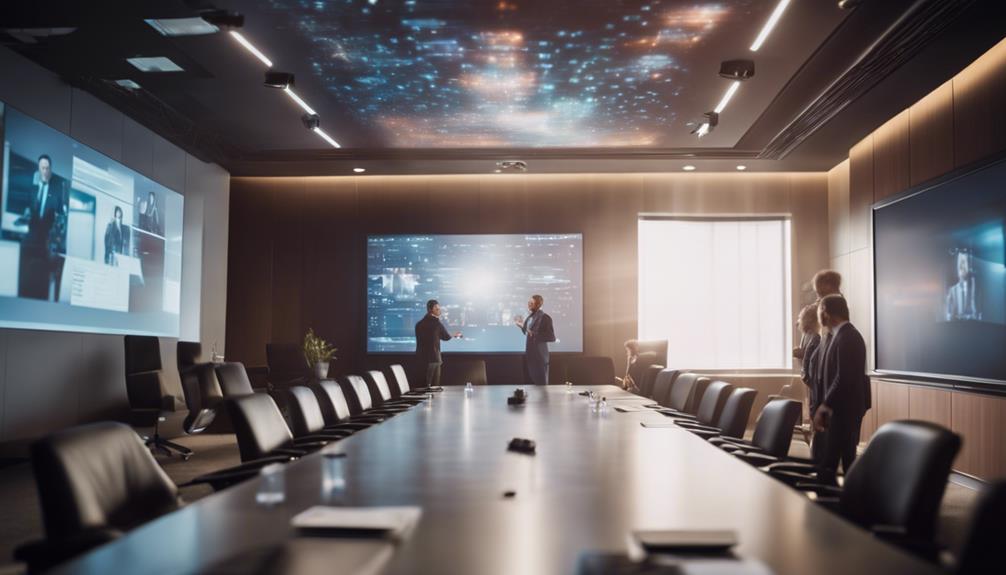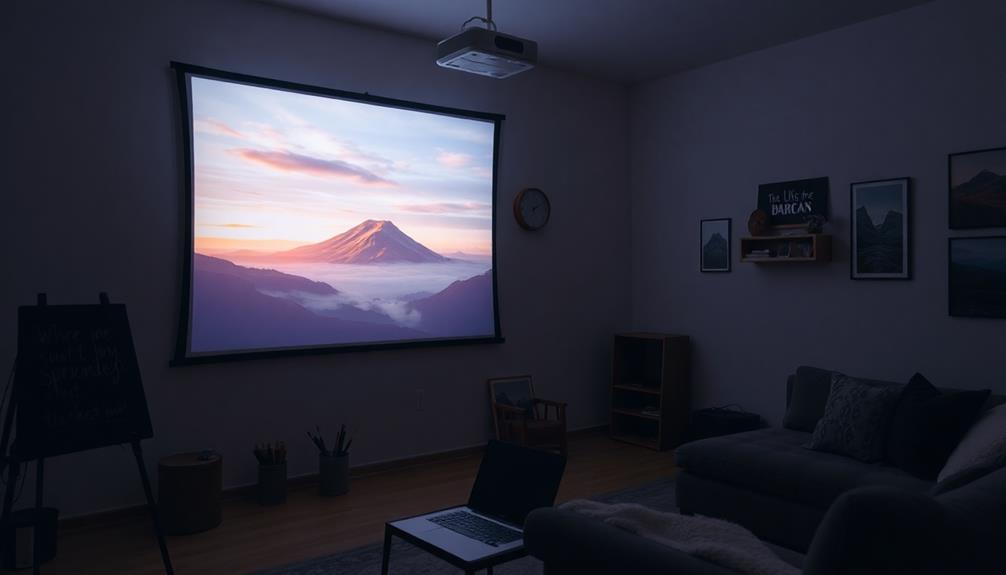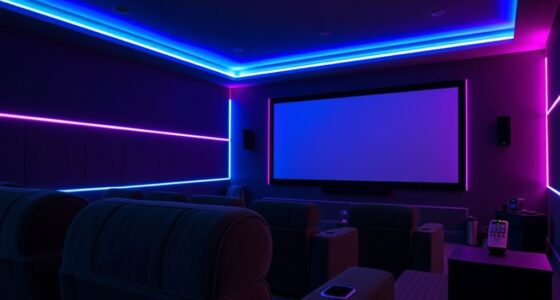Using a projector for video conferencing can boost engagement and visibility. Make certain you choose a high-quality projector with at least 2500 lumens for bright rooms and a minimum contrast ratio of 1000:1 for vibrant images. Position your projector at eye level and adjust brightness to match the room's lighting. Integrate high-quality microphones to guarantee clear audio and consider using interactive tools to enhance participation. Always test your setup beforehand to avoid technical issues. With these tips, you'll create a more effective meeting environment—there's much more to explore to perfect your video conferencing experience.
Key Takeaways
- Choose a projector with at least 2500 lumens brightness and a 1000:1 contrast ratio for optimal visibility in well-lit rooms.
- Position the projector at eye level and adjust brightness to match room lighting for enhanced viewing comfort.
- Use high-quality external microphones and consider ceiling-mounted options for clear audio capture during conferences.
- Incorporate interactive tools like polling and breakout rooms to boost participant engagement and collaboration.
Importance of Projectors

Projectors play an essential role in video conferencing by providing a larger display that enhances visibility for everyone in the room.
When you're in a larger space, traditional monitors just can't compete with the expansive view that projectors offer. This larger screen makes it easier for all participants to see shared content, fostering better collaboration and engagement.
Using high-quality projectors with brightness levels between 2500 to 4500 lumens is vital, especially in well-lit environments. This brightness guarantees that images remain clear and vivid, allowing everyone to follow along without straining their eyes.
Additionally, a higher contrast ratio in projectors results in deeper blacks and more vibrant colors, which greatly improves the overall image quality during presentations.
Modern projectors often come equipped with wireless connectivity options, simplifying the setup process. You won't have to deal with tangled cords or complicated connections, making your video conferencing experience smoother and more efficient.
Choosing the Right Projector

Selecting the right projector for video conferencing can greatly enhance the effectiveness of your meetings. Start by considering brightness levels, measured in lumens. If you're in a well-lit room, choose a projector with at least 2500 lumens to guarantee clear visibility for everyone involved.
Next, pay attention to the contrast ratio; look for at least 1000:1. This will give you deeper blacks and improved image quality during your presentations.
Features like lens shift and zoom capabilities are also important. They allow for versatile installation, making it easier to adapt to different room sizes.
Don't forget about connectivity. Verify the projector is compatible with HDMI connections, as this standard offers high-quality video and audio transmission.
Room Setup Considerations

To create an effective video conferencing environment, position the projector at eye level to keep everyone comfortable and engaged. This setup minimizes neck strain for both in-person and remote participants, guaranteeing a more enjoyable experience.
Here are some key room setup considerations:
- Adjust the projector's brightness to match your room's lighting; brighter projectors (2500 to 4500 lumens) work best in well-lit spaces.
- Use dual displays in larger rooms to enhance visibility, allowing participants to view both the presenter and shared materials simultaneously.
Additionally, regularly assess and calibrate your projector's settings for peak performance.
Pay attention to contrast ratios and screen gain to guarantee everyone can see visuals clearly.
Display Quality and Resolution

For clear and detailed video conferencing visuals, aim for high-definition projectors with a resolution of at least 1920×1080 (Full HD). This resolution guarantees that your video appears sharp, making it easier for participants to see each other and any shared content. If you want even better quality, consider investing in a 4K projector, which offers a resolution of 3840×2160. This is particularly beneficial for professional settings where detail is crucial.
Additionally, verify that your setup includes a quality headphone amplifier to enhance the audio experience, as sound clarity is just as important as visual clarity in video conferencing.
In addition to resolution, don't forget about brightness. A minimum of 2500 lumens is recommended to keep images clear and visible, even in well-lit conference rooms. The contrast ratio also plays a significant role; a higher ratio, like 1000:1 or greater, provides deeper blacks and more vibrant colors, enhancing the overall viewing experience.
Lastly, make sure your projector is compatible with HDMI cables. This will guarantee superior video and audio transmission quality, allowing for a seamless video conferencing experience. By prioritizing these display quality factors, you'll create an engaging and professional atmosphere for all participants involved.
Audio Integration Tips

When it comes to audio integration for video conferencing, proper microphone placement is essential to capture clear sound.
You'll also want to focus on enhancing sound clarity by using the right equipment and setup.
Let's explore some effective strategies to guarantee everyone hears and is heard during your meetings.
Microphone Placement Strategies
Strategically positioning microphones around the room guarantees clear audio capture while reducing background noise and feedback. Effective microphone placement strategies are vital in a conference room setting to make certain all participants can be heard clearly.
Here are some key strategies to reflect on:
- Position microphones 6-8 feet away from speakers to capture clear audio while minimizing unwanted noise.
- Utilize ceiling-mounted microphones like the Shure MXA910 for unobstructed sightlines and consistent coverage.
Additionally, incorporating individual lapel or headset microphones for active speakers can enhance clarity and reduce reliance on the room's acoustics.
Regularly assess your microphone placement and conduct sound checks to optimize audio quality for both in-person and remote participants during video conferences.
Enhancing Sound Clarity
Investing in high-quality audio equipment can greatly enhance sound clarity during video conferences, ensuring that every participant is heard clearly. Here are some best practices to follow:
| Audio Equipment | Purpose | Tips |
|---|---|---|
| External Microphones | Capture clear audio | Use high-quality models for larger rooms. |
| Ceiling-mounted Microphones | Reduce background noise | Consider Shure MXA910 for customizable coverage. |
| Acoustic Panels | Minimize echo and reverberation | Install in conference rooms for better acoustics. |
Regularly assess and maintain your audio equipment to prevent issues like audio feedback and muffled sound. Proper calibration of your system for the room's acoustics can considerably improve sound quality. Additionally, incorporating sound-absorbing materials like carpets can further aid in enhancing sound clarity. By following these strategies, you'll create a more effective and engaging video conferencing environment.
Enhancing Participant Engagement

To boost participant engagement during video conferences, you can integrate interactive tools and visual techniques.
Using features like Zoom's whiteboard not only encourages collaboration but also keeps everyone involved.
Additionally, focusing on clear visuals guarantees that your audience stays attentive and connected throughout the meeting.
Interactive Tools Integration
Integrating interactive tools in your video conferences can considerably boost participant engagement and foster dynamic collaboration. By leveraging these tools, you create an atmosphere where everyone feels involved and valued. Here are some effective strategies to enhance your sessions:
- Real-time collaboration: Use features like Zoom's whiteboard to allow participants to brainstorm and share ideas as they discuss.
- Instant feedback: Incorporate polling tools like Mentimeter or Slido to gather insights and encourage every participant to voice their opinions.
Additionally, consider using shared documents or platforms like Google Docs for collaborative note-taking, ensuring every voice is heard.
Visual aids such as interactive presentations can also help maintain focus and keep participants engaged throughout the session.
By incorporating these interactive tools, you not only enhance the overall experience but also empower participants to contribute actively, leading to more productive discussions and outcomes.
Take advantage of these strategies to create an engaging environment that fosters collaboration and creativity.
Visual Engagement Techniques
Using high-quality visuals not only captures attention but also greatly enhances participant engagement during video conferences. To achieve this, invest in high-definition projectors with at least 2500 lumens. This guarantees clear visuals even in well-lit rooms, keeping participants focused.
Incorporate dynamic visuals like infographics and videos, as studies show that visual aids can increase retention by up to 65%.
Position your projector screen at eye level to minimize viewer strain and maximize understanding; ideal angles greatly improve attention.
Additionally, consider implementing interactive features, such as live polling or Q&A sessions projected for everyone to see. This encourages real-time participation, fostering a more engaging experience.
Using a dual display setup can also enhance engagement. By showing video feeds of remote participants alongside presentation materials, you make certain all attendees feel included and part of the discussion.
These visual engagement techniques are essential for making your video conferencing sessions not just informative but also interactive and memorable. Emphasizing visuals and interactivity will lead to a more committed and involved audience, ultimately making your conferences more effective.
Troubleshooting Common Issues

Troubleshooting common issues with your projector can guarantee a smooth video conferencing experience and minimize disruptions. Here are some key areas to focus on:
- Display Issues: Verify your projector's compatible with your video conference setup, checking input and resolution settings.
- Audio Problems: If there's no sound, confirm that audio settings on both the projector and connected device are correct.
If you find the image blurry or distorted, adjust the focus and zoom settings, and clean the lens if necessary.
If participants can't view the presentation, double-check that the projector is powered on, connected to the video source, and that the right input source is selected.
These steps can save you time and frustration during your video conference. By addressing these common projector issues beforehand, you'll create an environment conducive to effective communication and collaboration.
Best Practices for Preparation

To guarantee a seamless video conferencing experience, it's vital to prepare your projector and setup well in advance of the meeting.
First, check that your projector is compatible with the video conferencing platform you'll be using. Test all connections ahead of time to avoid any technical hiccups during the call.
Next, familiarize yourself with the projector's settings, adjusting brightness and contrast to optimize image quality for your meeting room. Make sure everyone can see the content clearly, so set the projector at an appropriate distance to guarantee a legible image size without distortion.
Distributing any presentation materials or documents beforehand allows participants to prepare effectively and understand the content being projected. This step is pivotal in a collaborative environment, as it helps everyone stay on the same page.
Lastly, conduct a trial run of the entire video conferencing setup with the projector. This practice helps identify and resolve any potential issues, guaranteeing a smooth experience for both in-person and remote participants.
Taking these preparation steps can greatly enhance the effectiveness of your video conference.
Effective Meeting Facilitation

Effective meeting facilitation often hinges on establishing a clear agenda that outlines the topics and desired outcomes for all participants. This guarantees everyone understands the purpose and flow of the discussion, especially in conference rooms where attention is split between in-person and remote attendees.
- Engage all participants by soliciting input.
- Use projectors to display relevant information.
By frequently addressing remote attendees by name, you create an inclusive atmosphere that maintains focus throughout the meeting. Utilizing visual aids effectively, such as projectors, enhances discussions and keeps all materials organized and accessible.
It's crucial to limit distractions, so encourage participants to stay aligned with meeting objectives.
After the meeting, make certain everyone receives follow-up materials and a summary of outcomes to reinforce key points discussed. This clarity helps participants understand their next steps.
Post-Meeting Follow-Up

Promptly distributing meeting minutes and a summary of key decisions keeps everyone on the same page and reinforces shared understanding of the outcomes. For effective post-meeting follow-up, guarantee all participants, including remote participants, receive these documents right away.
Utilize collaborative tools like Google Docs or shared drives to make it easy for everyone to access materials and provide feedback.
Scheduling follow-up meetings or check-ins is essential to address any unresolved issues and to track progress on action items. This approach keeps the momentum going and guarantees that tasks are completed.
Encourage all participants to share their feedback on the meeting experience and the use of the projector. This will help you improve future video conferencing practices.
Additionally, maintain a record of attendance and participation. This allows you to identify engaged contributors and follow up with those who may have been less involved in the discussion.
Frequently Asked Questions
Can You Do a Zoom Meeting on a Projector?
Yes, you can definitely do a Zoom meeting on a projector. Just connect your device via HDMI, select the projector as your display, and adjust settings for a clear and effective presentation experience.
What Are the Best Practices for Video Calls?
For the best video calls, guarantee your camera's positioned at eye level, use a reliable internet connection, mute when not speaking, and eliminate background noise. Engage actively, and check your tech beforehand to avoid issues.
How Do You Make a Good Video Conferencing?
Did you know that 75% of professionals believe video conferencing improves communication? To make a good video conference, guarantee clear audio, maintain eye contact, minimize distractions, and engage participants actively throughout the discussion for effective collaboration.
What Is the Best Technology for Hybrid Meetings?
For hybrid meetings, you'll want high-definition projectors, dual displays, and quality audio systems. Don't forget wide-angle cameras and a reliable internet connection to guarantee everyone's engaged and communication flows smoothly.
Conclusion
So, you're all set to dazzle your colleagues with a projector for video conferencing, right? Just remember, it's not magic—if your tech fails, don't blame the ghosts in the machine!
Follow these tips, and you'll look like a pro instead of a deer caught in headlights.
If all else fails, just smile and nod while pretending you can see the screen. After all, who needs clarity when you've got charisma?
Happy projecting!
Hello, I’m Art, and I’m excited to be a part of the 1Home Theatre Projector team. As a writer, I’m here to contribute my knowledge and insights to help you achieve the ultimate home cinema experience. I understand that making decisions in the world of home entertainment can be complex, and I’m here to simplify the process for you.
















